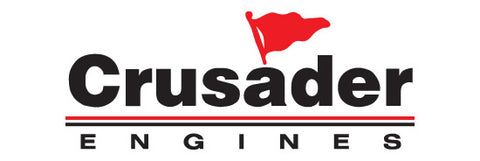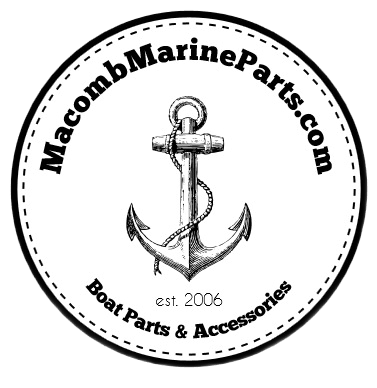
Crusader Marine Engine Identification Help
 Importance of Accurate Engine Identification for Marine Parts Procurement
Importance of Accurate Engine Identification for Marine Parts Procurement
When procuring replacement parts for your vessel's propulsion system, precise knowledge of the engine's brand, size, and type is paramount. Unfortunately, each marine engine manufacturer employs a unique identification system. Crusader engines, a mainstay in the larger cruiser market for decades, are typically recognizable by their signature blue paint. While this holds true for most models, a brief period saw Crusader engines finished in red. Due to these potential variations, accurately identifying your Crusader engine can be a multifaceted process. The following guide will detail the steps involved in locating the crucial identification information for your Crusader engine.
Identifying Crusader Marine Engines: A Comprehensive Guide
Unlike many marine engine brands, identifying Crusader engines requires acquiring both the model number and serial number for accurate determination. Additionally, knowing the approximate year of manufacture is highly beneficial.
This guide details the process for identifying Crusader engines across different production eras:
-
Pre-XL Series (Before 1992):
- Locate the identification tag on the engine's flywheel housing.
- This tag will display the model number, serial number, spark plug gap information, and the distributor model.
-
XL Series and Onward (1992 and After):
- A metal plate affixed to the engine block will provide the model and serial number.
Importance of Serial Number and Manufacturing Year:
- The serial number often corresponds to specific year ranges, aiding in pinpointing the engine's manufacturing year.
- Crusader serial number breakdowns for pre-2000 models can be complex. A chart outlining these ranges can be a valuable resource for deciphering the correct year.
- Post-2000 serial number breakdowns became more standardized following Pleasurecraft Engine Group's acquisition of Crusader in 1999.
By following these steps and referencing the appropriate resources for pre-2000 serial numbers, you can effectively identify your Crusader marine engine.
Finding Your Information
The location of the identification tag on Crusader engines varies depending on the model year.
Pre-XL Series (Prior to 1992):
- The identification tag is typically affixed to the flywheel housing of the engine.
- This tag should include the model number, serial number, spark plug gap specification, and distributor model.
XL Series (Introduced in 1992 and Later):
- The identification tag is a metal plate located directly on the engine block.
- This plate contains the engine's model number and serial number.
- Additionally, a specification decal can be found on one of the valve covers. This decal provides detailed engine information, including the model series, displacement, firing order, distributor model, and spark plug specifications.
Crusader Engine Serial Number to Year Chart
|
Engine S/N From |
Engine S/N Thru |
Year |
|
35865 |
38541 |
1982 |
|
38542 |
43469 |
1983 |
|
43470 |
50458 |
1984 |
|
50459 |
56633 |
1985 |
|
56634 |
64548 |
1986 |
|
64549 |
73099 |
1987 |
|
73100 |
80122 |
1988 |
|
80123 |
84967 |
1989 |
|
84968 |
87880 |
1990 |
|
87881 |
89297 |
1991 |
|
89298 |
91279 |
1992 |
|
81280 |
93416 |
1992 |
|
93417 |
95934 |
1993 |
|
95935 |
98570 |
1994 |
|
98571 |
100800 |
1995 |
|
100801 |
102521 |
1996 |
|
102522 |
103866 |
1997 |
|
103887 |
104618 |
1998 |
|
600001 |
600304 |
1999 |
|
600305 |
600999 |
2000 |
|
61xxxx |
2001 |
|
|
62xxxx |
2002 |
|
|
63xxxx |
2003 |
|
|
64xxxx |
2004 |
|
|
65xxxx |
2005 |
|
|
66xxxx |
2006 |
|
|
67xxxx |
2007 |
|
|
68xxxx |
2008 |
|
|
69xxxx |
2009 |
|
|
70xxxx |
2010 |
|
|
71xxxx |
2011 |
|
|
72xxxx |
2012 |
|
|
73xxxx |
2013 |
|
|
74xxxx |
2014 |
|
|
75xxxx |
2015 |
|
|
76xxxx |
2016 |
|
|
77xxxx |
2017 |
|
|
78xxxx |
2018 |
|
|
79xxxx |
2019 |
|
|
80xxxx |
2020 |
|
|
81xxxx |
2021 |
|
|
82xxxx |
2022 |
Identifying Crusader Marine Engine Models
Crusader Engines have employed various model numbering formats throughout their history. This guide simplifies the process of deciphering this information.
Pre-2000 Models:
Earlier Crusader engines utilized a straightforward model designation system. Examples include "305XL" and "454XLi." These codes directly indicated the engine size and model series.
2000-2005 Models:
Following Pleasurecraft Engine Group's acquisition in 1999, a more complex model numbering system was introduced in 2000. These ten-digit codes, like CXLXHFL245, provided detailed engine specifications.
- 1st space: Manufacturer
- C = Crusader
- 2nd space: Factory Freshwater/Closed Cooling
- Blank = Raw water cooling
- X = Fresh water cooling
- 3rd space: Engine rotation
- L = Left-hand rotation
- R = Right-hand rotation
- 4th space: Engine Type
- A = GM 5.7L (350 CID High Output)
- G = GM 5.0L (305 CID)
- K = GM 7.4L (454 CID)
- L = GM 5.7L (350 CID)
- N = GM 7.4L (454 CID High Output)
- Q = GM 6.0L (366 CID)
- X = GM 8.1L (496 CID)
- Z = GM 8.1L (496 CID High Output)
- 5th space: Drive Manufacturer
- H = Hurth
- T = Walters
- V = Velvet Drive (cast iron 71C/72C)
- W = Borg-Warner
- 6th space: Drive Function/Application
- F = Full reversing
- R = Reverse / Reduction
- V = V-Drive / Reversed risers
- 7th space: Propeller shaft rotation
- L = Left-hand rotation
- R = Right-hand rotation
- 8th thru 10th space: Drive Gear Ratio or Reduction
- Examples – 200 = 2.0:1, 150 = 1.5:1, 245 = 2.45:1
For models after 2006, the model number usually contains 8 digits. An example would be 02-600V-01. These digits represent the following:
- 1st thru 2nd spaces: Manufacturer code
- 3rd thru 5th spaces: Engine code
- 810 = GM 8.1L (496 CID, Multi-Port Fuel Injection)
- 811 = GM 8.1L (496 CID High Output, Multi-Port Fuel Injection)
- 600 = GM 6.0L (364 CID, Multi-Port Fuel Injection, LQ4 Block)
- 601 = GM 6.0L (364 CID, Multi-Port Fuel Injection, LY6 Block)
- 602 = GM 6.0L (364 CID, Multi-Port Fuel Injection, L96 Block)
- 570 = GM 5.7L (350 CID, Left-hand Rotation, Multi-Port Fuel Injection)
- 571 = GM 5.7L (350 CID, Right-hand Rotation, Multi-Port Fuel Injection)
- 572 = GM 5.7L (350 CID, Left-hand Rotation, Carbureted)
- 573 = GM 5.7L (350 CID, Right-hand Rotation, Carbureted)
- 500 = GM 5.0L (305 CID, Left-hand Rotation, Multi-Port Fuel Injection)
- 501 = GM 5.0L (305 CID, Right-hand Rotation, Multi-Port Fuel Injection)
- 502 = GM 5.0L (305 CID, Left-hand Rotation, Carbureted)
- 503 = GM 5.0L (305 CID, Right-hand Rotation, Carbureted)
- 6th space: Drive Configuration
- Blank = Direct Drive
- V = V-Drive
- 7th thru 8th spaces: Specification Code
Engine Size 350 or 454 ?
Prior to 1987, Crusader engine nomenclature can be confounding when determining replacement parts. Their large-block 454 cubic inch displacement (CID) engines were designated as "Model 350," while conversely, their small-block 350 CID engines were termed "Model 270." This inconsistency has resulted in considerable confusion regarding appropriate parts for these engines over the years.
To ensure you acquire the correct parts for pre-XL series Crusader engines, it's crucial to consider both the model designation and the engine displacement, typically specified in liters (e.g., 5.7 liters or 7.4 liters). When consulting a technician or parts supplier, referencing the engine size by liters might be more efficient to avert confusion. However, the model number remains essential for obtaining exact parts identification.
Crusader Engine Rotation: A Clarification
Crusader engine repair parts can vary depending on the engine's crankshaft rotation direction, a crucial detail for proper part selection. This can sometimes lead to confusion.
Crucially, engine rotation refers to the direction of the flywheel's rotation when the engine is running. An important distinction needs to be made, as some mistakenly identify rotation based on the propeller's direction. It's important to remember that propellers and flywheels can often rotate in opposite directions.
To ensure accurate identification, engine rotation should always be determined by viewing the flywheel end of the engine. A flywheel that rotates counter-clockwise is considered left-hand rotation, which is also commonly referred to as standard rotation. Conversely, a flywheel that rotates clockwise is considered right-hand rotation or opposite rotation.
Crusader Marine Engine Cooling Systems: Understanding Your Options
Crusader engines have been offered with various cooling system configurations throughout their history. Selecting the appropriate replacement parts necessitates a clear understanding of your specific engine's cooling system design.
Raw Water Cooling (RWC) vs. Fresh Water Cooling (FWC):
RWC Systems: Typically found in Classic series engines, these systems utilize raw saltwater directly for engine cooling.
FWC Systems: Introduced as standard in Captain's Choice series and available as an upgrade on others, these systems employ a closed loop with coolant to regulate engine temperature. Coolant is indirectly cooled by raw saltwater through a heat exchanger.
Benefits of FWC Systems:
Extended engine lifespan due to reduced exposure to corrosive saltwater
Improved engine performance through more consistent temperature control
Identifying Your Engine:
If unsure about your Crusader engine's cooling system type, the technicians at Macomb Marine Parts are happy to assist. Contact them via email at sales@macombmarineparts.com for expert identification and guidance.

